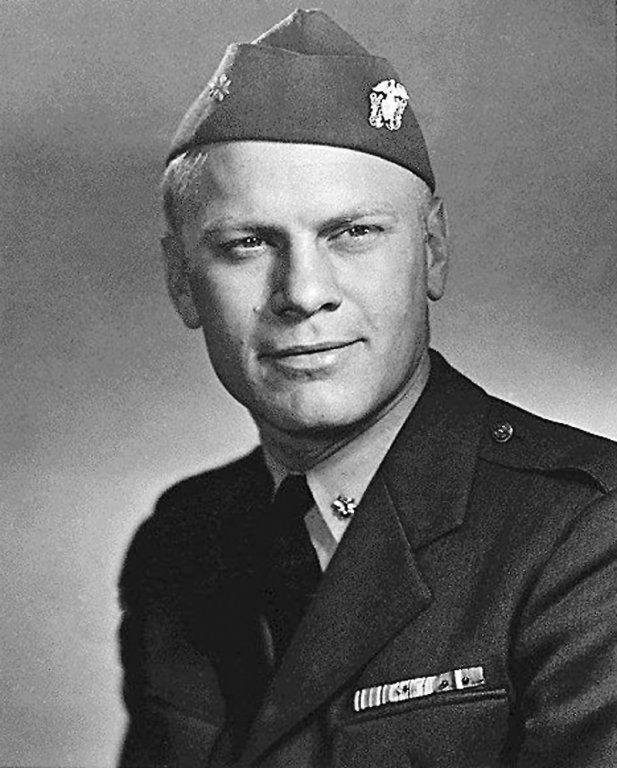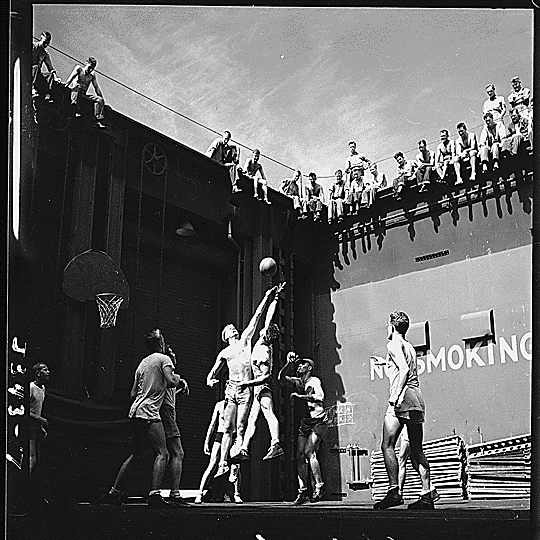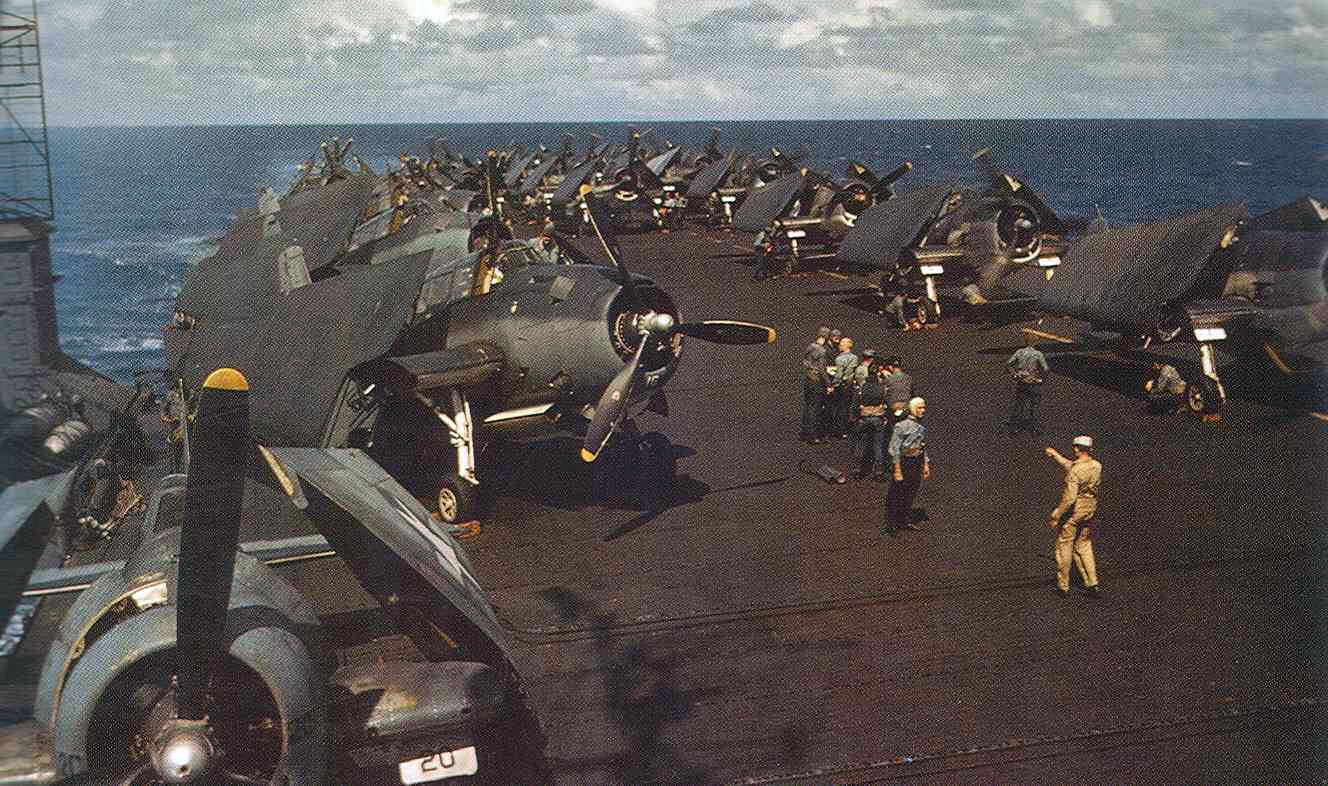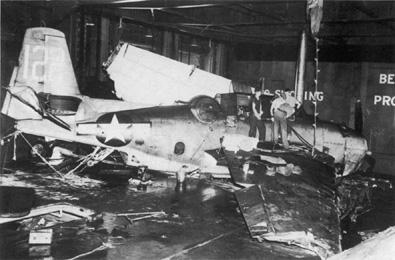
Gerald Ford, like many presidents. served in the US military before his election to public office. He had attended the University of Michigan and Yale and majored in law. He was a lawyer and partner in his own fledgling law practice. So why did he decide to join the military? He, like many Americans after the attack on Pearl Harbor. enlisted cut of a sense of duty. He obviously was not the only one who felt this way. This was ltle wsy that the military had worked up until shortly before Pearl Harbor. Large numbers of citizens were drafted or enlisted in the military to make up numbers under the command of professional officers. The end result was a military made up of a diverse mixture of fields and occupations. Lawyers like Ford worked alongside farmers and factory workers [4].
Ford volunteered for the Navy in January 1942, and was accepted in April. The Navy didn’t accept him until April on account of his football career. He was well known for being a stand-out on the Michigan team. At the beginning of his service, he was assigned as an instructor at the Navy Preflight School in Chapel Hill, North Carolina. He taught everything from elementary seamanship to strength and conditioning. He was also a coach for all the sports at the school, but primarily football, boxing and swimming. The fact that he was known as a football player added to his ability to train and teach new recruits particularly in conditioning.
After nearly a year at the Preflight School, Ford applied for sea duty. He was assigned to the pre-commissioning unit of the USS Monterey, a light aircraft carrier, in February 1943. Pre-commissioning units (PCUs) are the first sailors aboard ships and help to calibrate equipment, run sea trials, and other tests that are required before the ship goes to sea for the first time. Many in the pre-commissioning units also become “plankowners,” sailors who are aboard for the commissioning of the ship. In the case of the Monterey, Ford was aboard the ship for commissioning and would stay with it until late 1944. Pre-commissioning duties took the Monterey and her crew almost 4 months, and it wasn’t until June that Monterey was commissioned. After a shakedown cruise, Monterey departed for the Pacific [7].
The USS Monterey

The ship that would become the USS Monterey was laid down as the light cruiser USS Dayton. It was re-designated a light carrier in March 1942. The USS Monterey was named for the Mexican-American War Battle of Monterey. It was one of nine Independence-class aircraft carriers. Early on, American planners realized that the aircraft carrier, not the battleship, would be the deciding factor in the Pacific. Having lost multiple aircraft carriers in battles through mid-1942, planners looked for hulls that were already laid down that could be converted to aircraft carriers. Nine hulls of Cleveland-class light cruisers were selected. These were smaller than the fleet carriers of the Yorktown and Lexington-classes, but they were a quick and easy solution to the problem of having at times just a single front-line carrier in the Pacific.
The smaller ships carried a complement of up to 45 aircraft. In the beginning of the war, these were relatively even between fighters, dive bombers and torpedo bombers. Independence-class carriers typically had fighter-heavy complements later in the war, due to the change in use of the ships. The ships went from being used as smaller front-line carriers to more escort roles. They were usually assigned to air cover or for supporting landings. It was in this role that the only ship of the class to be lost, USS Princeton, was scuttled after kamikaze attacks. The class was also valuable because of its speed. Being based on cruiser hulls, these ships were faster than the other escort and light carriers, and were able to keep up with the fast carriers and battleships.
Ford served aboard Monterey as an assistant navigator, athletic officer, and antiaircraft gunnery officer. Carriers had a great deal of overlap due to the sheer number of jobs that needed to be done. Abroad carriers, a large portion of the crew was responsible solely for the aviation portion of the ship, with the other portion serving as the crew like on a normal ship. As such, It was not rare for an officer like Ford to have multiple jobs aboard a ship. A light carrier like Monterey had slightly over half the number of crew of an Essex or Yorktown-class carrier, so the overlap was further increased.

As a matter of course, most officers on carriers had some navigation training, and the title of assistant navigator belonged to many officers. However, he didn’t think much of his ability to navigate the ship, and was glad there was another navigator. At a reunion gathering of Monterey’s crew in 1975, he had this to say:
Let me just say, I was the assistant navigator under Pappy Atwood, and it’s fortunate that the ship relied on Pappy Atwood’s sightings rather than mine. And I hope that my decisions as President are more accurate than my sightings as assistant navigator. [2]
As an antiaircraft gunnery officer, he commanded a Bofors 40mm cannon battery of 4 guns. Like navigating, this was a skillset that nearly all officers had training in. The title of athletic officer was exclusively Ford’s. Once again, his football background was part of his naval service. He was responsible for overall fitness of the crew, leisure sports and activities, and even the occasional inter-ship game of basketball or football. As with his time at the Preflight Academy, sports and fitness were a large part of his service in the Navy. [5]
Ford and Monterey in action
Ford and Monterey’s first action came in November 1943 at the Gilbert Islands. Arriving 19 November, the ship helped secure the Makin Island and subdue Japanese resistance throughout the island chain. Throughout December and early 1944, the carrier participated in strikes on New Ireland, New Guinea, and landings in the Marshall Islands. After the Marshall Islands campaign, she was attached to Task Force 58, and took part in raids all over the Pacific. She also participated in the Battle of the Philippine Sea, otherwise known as ‘The Great Marianas Turkey Shoot’ that broke the back of the Japanese Carrier force. Monterey then joined Task Force 38 and William F. Halsey’s 3rd Fleet. It is with the 3rd Fleet that Monterey participated in the largest naval battle in history: Leyte Gulf. It would also be with the fleet that the Monterey would receive its worst damage. Not from the Japanese, but from nature.

Before the natural threat to Monterey, it fought at the Battle of Leyte Gulf. It filled the role of most of the light carriers, providing air cover to the landings. Later in the battle, it helped to bomb the Southern Force Japanese fleet, on the whole, not doing much in the way of damage to any of the ships. This force would be all but destroyed in the last great gun-to-gun battleship battle in history at Surigao Strait on 22 October, 1944. The Monterey was not finished at Leyte, however. As the Center Force, a collection of the largest battleships and cruisers the Japanese had left, steamed toward the landing forces in the gulf, a force of tiny ‘tin can’ destroyers, destroyer escorts and escort carriers was all that stood in its way. After the staggeringly heroic actions of the small ships against opponents 30 times their size, the force of tiny ships managed to fend off their adversaries until aid, including the Monterey, arrived. Monterey launched everything she could to help fight off the attackers, and was one of the few ships to be involved in both of the battles against the Southern and Center forces [7].
Typhoon Cobra
After fighting at Leyte, the Monterey and Ford stayed with the 3rd Fleet. In December, Admiral Halsey unwittingly turned the fleet into the path of a typhoon. It was the most damaging action of the war for the 3rd Fleet, and far surpassed any damage done by the Japanese. In the end, 790 men lost their lives. The material loss totaled 3 destroyers sunk, damage to 5 light carriers (Monterey severely), a prop shaft bent on USS Iowa and 21 other ships, ranging from destroyers to cruisers. She would eventually limp back to Bremerton, Washington for major repairs. Surprisingly, Monterey was one of only 3 ships that needed to be overhauled at naval shipyards stateside. [1]

In addition to the ships lost and damaged, more than 100 aircraft were also swept off carrier decks. The plunging seas also caused aircraft to slide around on the hangar deck. Abroad Monterey, a TBD Devastator torpedo bomber broke loose and slammed into the bulkhead. This aviation gas to spill, and after a spark, it ignited. Ford later remembered thinking that it would be ironic if the ship burned and sunk in the middle of a typhoon. Ford was officer on deck during this time, the call to general quarters having come long before the storm got terrible. He was ordered by Captain Ingersoll to assess the fire raging on the hangar deck. He went down, observed the fire was being fought effectively by the damage control crews, and went back to report. On his way back up the heaving decks and stairways slick with rain, he slipped and nearly went overboard. He managed to stay abroad and report back to the captain that the fire was under control.
Much has been said about Ford’s contribution to save his ship. There are reports of his heroism, and he has, by his own admission, occasionally been given more credit than he deserves. At the reunion gathering in 1975, he had only this to say:
Then, of course, the climax was the typhoon on December 18 and 19 of 1944. I can recall most intimately the coolness, the courage of the skipper. I happened to be on the bridge as the officer of the deck during general quarters, and we were in general quarters a long time.
The word came from the Admiral, “Abandon ship, if you so order.” I am not sure that’s the way it went but one out of the four boilers was in operation, the fire pumps were manned, the hangar deck fire was extinguished, and the Monterey, after about 7 hours dead in the water with one or two cruisers and three or four destroyers, got underway. [2]
Ford was where he was because of simple chance. He undoubtedly performed the task he had been ordered to do admirably, but to suggest he had fought the fires himself is stretching the truth a bit. [6]
In reality, navy ships had dedicated damage control teams spread throughout the ship to fight fires, pump water, and other things. These were ably commanded by other officers and sprang into action the moment they were needed. Several present-day articles have embellished the story a bit. The officer of the deck is a stand-in for the captain, and in times of crisis (like battles or storms) the officer can be ordered to supervise operations of a certain part of the ship or to report on damage, as Ford did, among other things.
Interestingly, Ford was not the only future president to be caught in the typhoon. George H.W. Bush, at the time also a lieutenant, was also caught in the storm aboard USS San Jacinto, another Independence-class carrier. His ship was also damaged, but not to the extent of Monterey. Few ships in the 3rd Fleet totally escaped damage that day.
After the fire and other typhoon damage, Monterey was declared unfit for service and was ordered to Bremerton, Washington for repairs. It was here that Ford left the ship for stateside duty. He spent from April 1945 in active duty, serving on staff at several different schools around the country before being discharged in February 1946. He then served in the Naval Reserve until 1963, when, as a representative from Michigan, he resigned.
Ford gave his military service as one of many reasons to enter politics in his later life. He ran in the 1948 election just 2 years after his honorable discharge from the Navy. He had come from an isolationist Midwest, and faced the fact that the world would not leave the United States alone. His military service opened his eyes, in a number of ways, to the wider world. He brought these revelations back with him to Grand Rapids, Michigan. He won a seat in the House of Representatives, and successfully defended it 12 times, until he was chosen as Vice President. He then took the office as the 38th President of the United States in 1974, when President Nixon resigned. From the creation of the United States, many Presidents have served in the military. From the generals of Washington, Grant, and Eisenhower to the lieutenants of Ford and Bush Sr., the military has had as much of an effect on politics, as politics have had on it.
Primary sources:
- Action Report (1944). USS Monterey (CVL 26) US Naval History & Heritage Command
- Gerald Ford (1975). Remarks at a Reunion With Crewmembers of the U.S.S. Monterey. The American Presidency Project
- Gerald Ford (1976). Exchange With Reporters on Arrival at Rockford, Illinois. The American Presidency Project
Secondary Sources:
- Naval Historical Center (2006). The Navy Career of Gerald Ford. Military.com
- Drury, Robert and Clavin, Tom (2006). How Lieutenant Ford Saved his Ship.
- Cannon, James (1994). Time and Chance: Gerald Ford’s Appointment with History. Ann Arbor.
- Navy History (2013). Lieutenant Gerald Ford and Typhoon Cobra.
